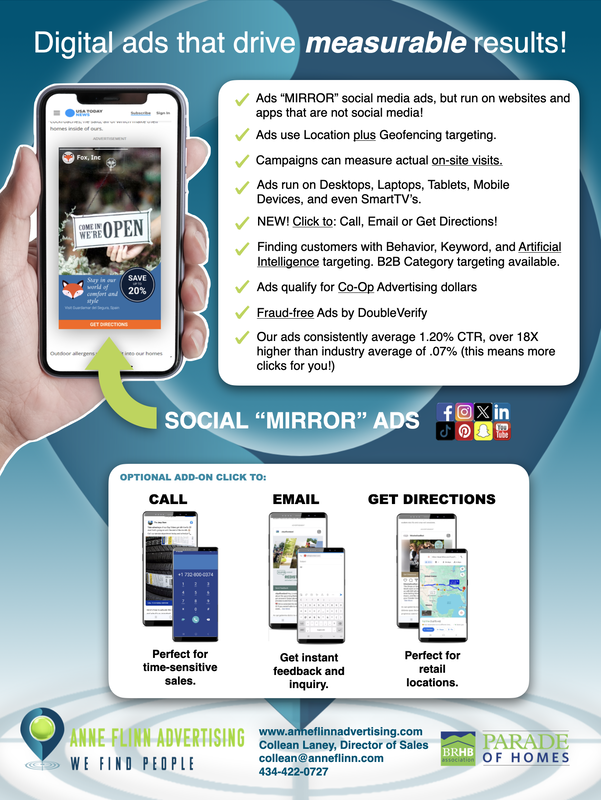|
Choose Package:
$500 spend and get 34,000 targeted impressions - normally not available as a stand-alone option. $1000 spend get 67,000 targeted impressions - normally not available as a stand-alone option. $1500 spend get 100,000 targeted impressions - packages typically start at this level.
Display advertising combines creativity, strategy, and analytics. By focusing on clear goals, understanding your audience, and optimizing every aspect of your ad, you can create campaigns that deliver meaningful results for your brand. Start implementing these best practices today to maximize the impact of your display ads.
| |||||||
Samples
Click on link, when Bloomberg opens, scroll to find ad:
Bramante Homes Sample: https://socialmirror.reporting.zone/demo/bloomberg-preview?mv-preview&mvpi=6399ecdb967648acb9328ac01b5ff641
Charlottesville Remodeling Sample: https://socialmirror.reporting.zone/demo/bloomberg-preview?mv-preview&mvpi=0ac9c42cd467402a9587e5bae808d14c
Charlottesville Remodeling Sample: https://socialmirror.reporting.zone/demo/bloomberg-preview?mv-preview&mvpi=0ac9c42cd467402a9587e5bae808d14c
Top 10 Best Practices for Effective Display Advertising
Display advertising is a powerful tool to build brand awareness, generate leads, and drive conversions. However, standing out in the crowded digital arena requires carefully crafted strategies. Here are ten best practices to create effective and impactful display ads:
1. Define Your Goals ClearlyBefore creating an ad, decide what you want to achieve. Are you aiming to drive website traffic, generate leads, increase brand awareness, or promote a specific product? A clear objective sets the foundation for a focused and effective campaign.
2. Know Your AudienceUnderstanding your target audience’s demographics, behaviors, and preferences is vital. Tailor your ad messaging, visuals, and placements to resonate with the people most likely to engage with your brand.
3. Use Eye-Catching VisualsYour visuals should grab attention immediately. Invest in high-quality images or graphics that align with your brand and message. Use vibrant yet complementary colors to create an ad that pops without being overwhelming.
4. Offer a Clear and Compelling Value PropositionWhy should someone click on your ad? Highlight your unique selling points (USPs) or offer an attractive incentive, such as discounts, free trials, or premium features. Make the value instantly clear to your audience.
5. Keep Your Message SimpleDisplay ads have limited space to convey your message. Stick to short, engaging phrases that align with your goal. Avoid cluttering the ad with too much text. The visual and copy should combine to create a clear, cohesive message.
6. Ensure a Strong Call to Action (CTA)A clear and actionable CTA is crucial. Use phrases like “Shop Now,” “Get Started,” “Learn More,” or “Sign Up Today” to guide users to the next step. Make your CTA stand out visually to ensure maximum engagement.
7. Optimize for MobileMany users now interact with display ads on their phones. Make sure your ads are responsive and optimized for different screen sizes to deliver a seamless experience across all devices.
8. Leverage Remarketing CampaignsRemind users who’ve previously interacted with your brand to revisit and take action. Remarketing ads target those who have already shown interest, making them more likely to convert.
9. Test and ExperimentRun A/B tests on different elements of your ad, such as visuals, headlines, CTAs, and offers. Analyze results to determine what resonates most with your audience and refine your campaigns accordingly.
10. Measure Campaign Performance
Track key metrics like click-through rates (CTR), conversions, and impressions to evaluate your campaign’s success. Use tools like Google Ads or Facebook Ads Manager for detailed insights and adjust your strategy as needed.
Display advertising is a powerful tool to build brand awareness, generate leads, and drive conversions. However, standing out in the crowded digital arena requires carefully crafted strategies. Here are ten best practices to create effective and impactful display ads:
1. Define Your Goals ClearlyBefore creating an ad, decide what you want to achieve. Are you aiming to drive website traffic, generate leads, increase brand awareness, or promote a specific product? A clear objective sets the foundation for a focused and effective campaign.
2. Know Your AudienceUnderstanding your target audience’s demographics, behaviors, and preferences is vital. Tailor your ad messaging, visuals, and placements to resonate with the people most likely to engage with your brand.
3. Use Eye-Catching VisualsYour visuals should grab attention immediately. Invest in high-quality images or graphics that align with your brand and message. Use vibrant yet complementary colors to create an ad that pops without being overwhelming.
4. Offer a Clear and Compelling Value PropositionWhy should someone click on your ad? Highlight your unique selling points (USPs) or offer an attractive incentive, such as discounts, free trials, or premium features. Make the value instantly clear to your audience.
5. Keep Your Message SimpleDisplay ads have limited space to convey your message. Stick to short, engaging phrases that align with your goal. Avoid cluttering the ad with too much text. The visual and copy should combine to create a clear, cohesive message.
6. Ensure a Strong Call to Action (CTA)A clear and actionable CTA is crucial. Use phrases like “Shop Now,” “Get Started,” “Learn More,” or “Sign Up Today” to guide users to the next step. Make your CTA stand out visually to ensure maximum engagement.
7. Optimize for MobileMany users now interact with display ads on their phones. Make sure your ads are responsive and optimized for different screen sizes to deliver a seamless experience across all devices.
8. Leverage Remarketing CampaignsRemind users who’ve previously interacted with your brand to revisit and take action. Remarketing ads target those who have already shown interest, making them more likely to convert.
9. Test and ExperimentRun A/B tests on different elements of your ad, such as visuals, headlines, CTAs, and offers. Analyze results to determine what resonates most with your audience and refine your campaigns accordingly.
10. Measure Campaign Performance
Track key metrics like click-through rates (CTR), conversions, and impressions to evaluate your campaign’s success. Use tools like Google Ads or Facebook Ads Manager for detailed insights and adjust your strategy as needed.


